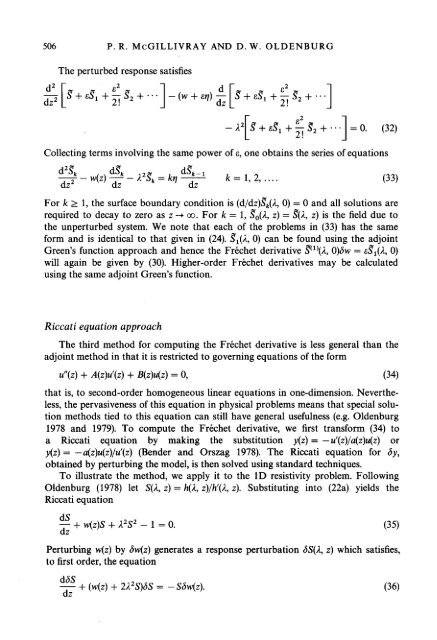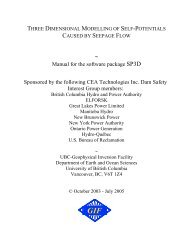METHODS FOR CALCULATING FRÃCHET DERIVATIVES AND ...
METHODS FOR CALCULATING FRÃCHET DERIVATIVES AND ...
METHODS FOR CALCULATING FRÃCHET DERIVATIVES AND ...
Create successful ePaper yourself
Turn your PDF publications into a flip-book with our unique Google optimized e-Paper software.
506 P. R. McGILLIVRAY <strong>AND</strong> D. W. OLDENBURGThe perturbed response satisfies1E2E2[s + &SI + - s2 + * *. - (w + EU)dz 2!dz2 2!s + ES1 + - s2 + . . .s" + &fl11E2+ - S2 + = O. (32)2!Collecting terms involving the same power of E, one obtains the series of equationsd2$k dgk dgk - 1--dz2 dz dzW(Z) - - A'Sk = kq - k = 1, 2, ....For k 2 1, the surface boundary condition is (d/dz)g,(A, O) = O and all solutions arerequired to decay to zero as z 4 CO. For k = 1, $,(A, z) = $(A, z) is the field due tothe unperturbed system. We note that each of the problems in (33) has the sameform and is identical to that given in (24). $,(A, O) can be found using the adjointGreen's function approach and hence the Fréchet derivative f(')(A, 0)6w = &$,(A, O)will again be given by (30). Higher-order Fréchet derivatives may be calculatedusing the same adjoint Green's function.(33)Riccati equation approachThe third method for computing the Fréchet derivative is less general than theadjoint method in that it is restricted to governing equations of the formUyz) + A(z)u'(z) + B(z)u(z) = O, (34)that is, to second-order homogeneous linear equations in one-dimension. Nevertheless,the pervasiveness of this equation in physical problems means that special solutionmethods tied to this equation can still have general usefulness (e.g. Oldenburg1978 and 1979). To compute the Fréchet derivative, we first transform (34) toa Riccati equation by making the substitution y(z) = - ur(z)/a(z)u(z) ory(z) = -a(z)u(z)/u'(z) (Bender and Orszag 1978). The Riccati equation for ay,obtained by perturbing the model, is then solved using standard techniques.To illustrate the method, we apply it to the 1D resistivity problem. FollowingOldenburg (1978) let S(A, z) = h(A, z)/h'(Â, z). Substituting into (22a) yields theRiccati equationdS- + w(z)S + Â2S2 - 1 = o.dz(35)Perturbing w(z) by 6w(z) generates a response perturbation 6S(A, z) which satisfies,to first order, the equationd6S- + (w(z) + 2A2S)dS = -SGw(z).dz(36)



